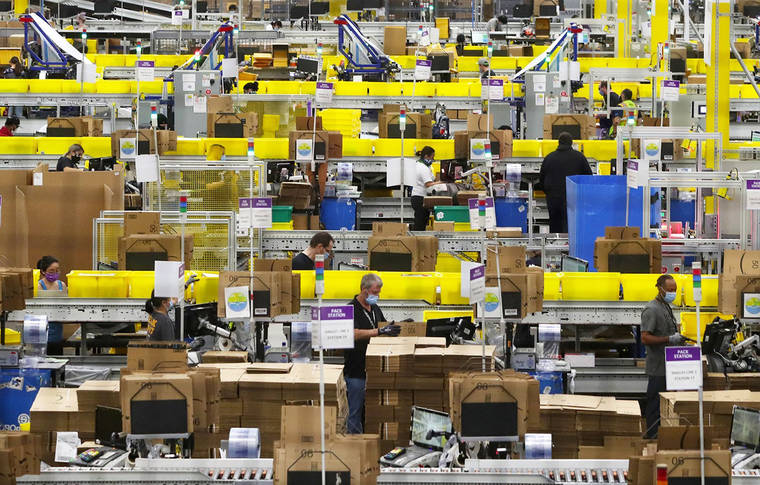Amazon raked in $113 billion in three months — and that’s a letdown
Amazon continues to rake in cash during the pandemic.
But for the first time in a year, there’s an inkling that the company’s record-setting pace of growth may be slowing ever so slightly, sending Amazon shares down in after-hours trading. Shares opened Friday morning down almost 7%.
By any standard but the outsize performance of the pandemic, Amazon had a standout quarter. The company reported Thursday earnings of $7.8 billion, a 48.4% increase from the same period last year, and $15.12 in earnings per share. The figure blew past analysts’ expectations of $12.22 per share.
Amazon charted its third consecutive quarter of $100-billion-plus sales, recording $113.1 billion in revenue in the three months from April to June for a 27% increase over the same period last year. That was in line with the company’s forecasts, but slightly lower than analysts’ expectations of $115 billion. In the preceding year, Amazon revenues grew roughly 40% per quarter, on average.
The retail giant was always going to struggle to show up last year’s blockbuster results. As shoppers stuck indoors by the pandemic embraced online ordering, Amazon earnings doubled nearly every quarter in the past year, compared to the same periods a year earlier. In the January-to-March quarter, they .
Discounting the effects of Prime Day, which this year spanned June 21 and 22, Amazon’s second-quarter sales growth hovered in the midteens, slightly weaker than historical averages, said Chief Financial Officer Brian Olsavsky on a call with analysts. Amazon expects sales growth to continue to lag its pandemic performance, Olsavsky said.
Still, Amazon’s immensely profitable second-quarter results indicate that even as some consumers return to pre-pandemic shopping habits, many continue to buy online — and specifically, on Amazon.
The company’s next-quarter guidance anticipates earnings of between $2.5 billion and $6 billion, a reduction from the same time last year, when Amazon charted $6.33 billion in profit. Those earnings are expected to come on sales of between $106 billion and $112 billion, a 10% to 16% growth rate compared to the same time last year.
An end to COVID restrictions “does tend to lead [customers] to do other things besides shop,” Olsavsky said. Despite rising number of COVID-19 cases, largely caused by the delta variant of the coronavirus, and new federal and state guidance advocating a return to mask-wearing indoors, the company does not expect new restrictions on in-person business in the U.S. and Europe, he added.
Thursday’s earnings release was the first for the company’s new CEO, Andy Jassy, formerly the head of Amazon Web Services. The results aren’t a referendum on Jassy’s performance in the top seat — Jassy replaced Amazon founder Jeff Bezos on July 5, after last quarter’s books had closed.
Amazon nevertheless seems to have seized the occasion to reintroduce Jassy, releasing a 42-minute video interview Thursday morning in which the new CEO shared his vision for implementing the company’s two new Leadership Principles, now part of the set of standards against which employee performance is judged: “strive to be Earth’s Best Employer” and “success and scale bring broad responsibility.”
In a departure from Bezos’ philosophy that workers are inherently lazy — a viewpoint evident in Amazon’s goals for employee attrition and the greater-than-100% annual turnover rate at Amazon warehouses — Jassy emphasized a culture of long-term employee development.
“We need to keep asking ourselves, over and over, individually and collectively, whether we’re building the best place for employees to make customers’ lives better while having a satisfying and fulfilling career,” Jassy said. “We won’t get it right all the time. … But we are committed to building the best place for people to want to work over a long period of time.”
Amazon’s new tune on retention may be driven in part by the company’s struggles to attract enough workers to staff its ever-growing roster of warehouses, built to handle delivery volumes that have doubled in the last two years.
The company pushed forward a scheduled wage increase from October to May, and has been touting incentives like hefty sign-on bonuses to lure new workers. Amazon’s current staffing levels are adequate, “but not without cost,” Olsavsky told analysts. Wage increases are the “biggest contributor to inflationary pressures” for the company, he added.
Amazon expects to start spending less on COVID-19 measures in its warehouses this summer, even as workers say they continue receiving a steady drumbeat of notifications that their co-workers have tested positive for the disease.
The company announced an end to its on-site COVID-19 testing program earlier this month, and three warehouse workers at the company’s flagship Kent complex say Amazon has stopped handing out masks and has abandoned social distancing precautions and temperature checks.
Amazon is monitoring the Delta variant, Olsavsky said in a call with journalists, and will ramp up its COVID precautions if required. “For the record, we’re anti-Delta.”
In his interview, Jassy also touched on the company’s recent efforts to become more involved in the communities in which it operates, acknowledging that hadn’t been a priority for much of the company’s 27-year history.
It’s only been the “last few years as a company that we’ve been getting meaningfully more involved in our communities and neighborhoods,” Jassy said, calling out Amazon’s efforts to reduce and offset greenhouse gas emissions, build and preserve affordable housing and invest in Black-owned businesses.
One longtime Amazon promise related to its climate impact was partially realized Thursday: The company announced the rollout of the first batch of 100,000 electric delivery vans it ordered two years ago from EV startup Rivian.


